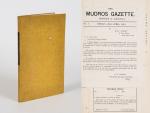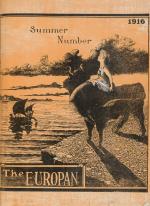[Wemyss, Original SIGNED Portrait of the Sir Rosslyn Wemyss
Original SIGNED Portrait of Sir Rosslyn Wemyss, while Rear Admiral, Senior Officer and Governor of Moudros / Mudros] – together with (loosely inserted into): [Moudros] Mudros Papers: 1915-1918 / Spectacular compilation with official orders by Rear Admiral Rosslyn Erskine Wemyss and Admiral of the Fleet Sir John Michael de Robeck to Harry Charles Lukach (then Government Secretary on Mudros) and bound in the rear also four (4) original editions of the Humorous Dardanelles-Campaign-Newspaper “Europan” with satirical content on the Gallipoli – campaign. / [With original printed Government Notices by Command of Government Secretary H.C.Lukach [that is later Sir Harry Luke] in which Luke is asked by Admiral R. E. Wemyss and Admiral de Robeck in three notices to alert the citizens of Mudrous / Mudros on the greek island of Lemnos of important developments and orders to be followed: for example Cyprus-content: “Famagusta, 1st October 1918: The Public is hereby warned to abstain carefully from causing any interference with or injury of the telephone lines connecting Famagusta and Cape Andreas and Famagusta and Cape Greco. Any Person convicted of an infringement of the above order will be severely dealt with under Martial Law – By Order H.C.Lukach, Provost-Marshal”] / The initial order by Admiral Wemyss is the first order published in the Mudros Gazette and dated Friday, 23rd April, 1915 in which Wemyss sends his order from the H.M.S. Hussar to Luke: “H.C.Lukach, Esq. – Government Secretary – I shall be obliged if you will inform the Local Authorities that it is my intention that in future no person, not a native or a resident in the Island, shall be allowed to establish him or herself in Mudros and its vicinity without my special authority in writing….” [Several other printed orders follow, publish autonomously by Lukach].
Mudros, Authority, c. 1918. 33,5 cm x 21,5 cm. Size of the Original Photograph Portrait of Sir Rosslyn Wemyss: Image: 14.5 cm wide x 19.5 cm high, signed in ink and mounted on board which measures 17.5 cm wide x 22.7 cm high. / The Volume with official documents counts c. 100 pages. Original Hardcover. The extremely rare photograph of Sir Rosslyn Wemyss in very good condition and beautifully signed and only with some minor signs of wear / The Mudros – Volume of official orders by Wemyss, de Robeck and Lukach with some minor staining to boards, very occasional only some foxing to pages. Otherwise in excellent condition.
Includes “The Mudros Gazette”, various Mudros Government Notices, illustrated “Europan”, and a Famagusta Government Notice dated October 1st, 1918.
Detailed List of Contents:
The Mudros Gazette No.1 (23rd April, 1915) – with the initial notice to Harry Charles Lukach by Rear Admiral Rosslyn Wemyss about the Allied Powers in Lemnos and the necessity of getting authority in writing for establishing oneself in Mudros
The Mudros Gazette No. 2 (9th July, 1915) – Notice that no boats or vessels other than Allied and Greek Ships of War, Allied Transports and Allied Auxiiaries will be permitted to remain in the Port of Mudros and Notice 9 issues the necessity of restrictions as to free circulation in Lemnos as well that ALL persons NOT being natives of or domiciled in Lemnos are warned to apply for a permit !
The Mudros Gazette No. 3 (10th September, 1915) – with Notice by Admiral J.M.de Robeck about prohibited areas inside the lines Cape Suvla to Kusu Bay, Cape Niger (Imbros) to the southernmost of the Rabbit Islands, thence to Palaeo Kastro (North of Bashika Bay) / With a special Notice to the Mukhtars of Romanos, Lykhna, Sarpi, Pisperago, Portianos, Simandria and Kontea about the prohibition to sell alcohol !
The Mudros Gazette No.4 (8th October, 1915) – with notice that no person, military or civilian, has permission to slaughter animals in around town but must do so in the slaughterhouse constructed for that purpose at the southern end of Mudros Bay…
The Mudros Gazette No. 5 (11th February, 1916) – with Notice 26: ALL owners of land occupied or damaged by the British Military Authorities in Lemnos, who have not already sent in their claims for compensation, are hereby requested to forward such claims to the government Secretary
The Mudros Gazette No. 6 (9th June, 1916) – the Bay of Purnea is closed to Merchant shipping / ALL persons henceforth proposing to export from Lemnos any of the following goods: Skins (shee, goat, kid, lamb, etc.), Sesame Seed, Cotton Seed, Millet Seed, Wool, Tobacco, Raw cotton, Beans, are informed that they must previously obtain a certificate that the goods are not the produce of Germany, Austria-Hungary, Turkey or Bulgaria / Notice 32 addressed to Merchants in Lemnos desiring to import goods from the United Kingdom / Notice 35 – It is hereby notified for general information that until further notice the coffeeshops in Mudros town may keep open until 10:30 pm
Also included are several notices and specimen of Passes for Natives in Lemnos who want to pass between Military Zone of Mudros and the Rest of the Island /
Also included: NOTICE that a reward of 500£ (12500 drachmae) will be paid for information leading to the destruction of an enemy submarine (16th May 1915 – H.C.Lukach)
Also Included: THE EUROPAN – No.1 (Mudros, 1st April, 1916) with humorous pems and caricatures as well as an idea for an Explosive Golf Ball filled with TNT, called “The HUN” /
Also Included: THE EUROPAN – No.2 (Mudros, 1st May, 1916) with a humoruos Alphabet referring to Mudros (″A Mudrine Alphabet”) / A Dialogue: “Socrates in Mudros” / With an iluustration of “Grand Hotel – Ritz de Mudros” /
Also included: THE EUROPAN – No.3 (Mudros, June, 1916) with a story: “Pepys in Lemnos”
Also Included: THE EUROPAN – No.4 (Mudros, July, 1916)
Also included: Special Order of the Day by A. Lynden Bell on December 21st, 1915 regarding the successful evacuation of the ANZAC and SUVLA positions with a special congratulation by King George on the success of evacuation without loss of life /
Admiral of the Fleet Rosslyn Erskine Wemyss, 1st Baron Wester Wemyss, GCB, CMG, MVO (12 April 1864 – 24 May 1933), known as Sir Rosslyn Wemyss between 1916 and 1919, was a Royal Navy officer. During the First World War he served as commander of the 12th Cruiser Squadron and then as Governor of Moudros before leading the British landings at Cape Helles and at Suvla Bay during the Gallipoli campaign. He went on to be Commander of the East Indies & Egyptian Squadron in January 1916 and then First Sea Lord in December 1917, in which role he encouraged Admiral Roger Keyes, Commander of the Dover Patrol, to undertake more vigorous operations in the Channel, ultimately leading to the launch of the Zeebrugge Raid in April 1918.
Wemyss served in the First World War, initially as commander of the 12th Cruiser Squadron in the Channel Fleet and then, after being despatched to Lemnos with a brief to prepare the harbour of Moudros for operations against the Dardanelles in February 1915, as Governor of Moudros. He commanded a squadron for the British landings at Cape Helles on 25 April 1915 and also gave support for the British landings at Suvla Bay on the Gallipoli Front on 9 August 1915. When the Gallipoli Campaign was abandoned he was responsible for the successful re-embarkation of troops from Suvla Bay and from Ari Burnu on 20 December 1915. He was appointed a Knight Commander of the Order of the Bath in the 1916 New Year Honours.
Wemyss became Commander of the East Indies & Egyptian Squadron in January 1916 where he supported military operations on the Palestine Front. He encouraged the Arab Revolt under Emir Faisal and T. E. Lawrence: the latter said that “Wemyss acted godfather til the Arabs were on their feet”. Promoted to vice-admiral on 6 December 1916, he was appointed a Commander of the French Legion of Honour on 23 March 1917 and a Grand Officer of the Order of the Crown of Italy on 11 August 1917.
Returning to the Admiralty, Wemyss was appointed Second Sea Lord in September 1917 and then Deputy First Sea Lord in October 1917. Following Sir Eric Geddes’s decision to dismiss the First Sea Lord, Admiral Sir John Jellicoe, Wemyss was appointed Jellicoe’s replacement in December 1917. As First Sea Lord he encouraged Admiral Roger Keyes, Commander of the Dover Patrol, to undertake more vigorous operations in the Channel, ultimately leading to the launch of the Zeebrugge Raid in April 1918. He was advanced to Knight Grand Cross of the Order of the Bath in the 1918 Birthday Honours and represented Britain at the Armistice in November 1918. He was awarded the Grand Cross of the French Legion of Honour on 17 January 1919 and the French Croix de Guerre on 15 February 1919. He was also promoted to full admiral on 21 February 1919, awarded the Grand Cross of the Romanian Order of the Crown on 17 March 1919 and presented with the American Distinguished Service Medal on 16 September 1919.
Wemyss was the senior British representative at the signing of the armistice that ended active hostilities in the war. It was Wemyss who made the decision, much to the anger of British Prime Minister David Lloyd George, to have the ceasefire to come into effect at 11.00 a.m. Lloyd George wanted it to take place at 2.30 p.m. so that he could make the announcement in the House of Commons. Wemyss realised that 11 a.m on the 11th day of the 11th month had a strong, poetic quality about it; besides, by 2.30 p.m. more soldiers could be unnecessarily killed. After attending the Paris Peace Conference as Britain’s naval representative and arranging for the end of the food blockade and hence unblocking the negotiations, Wemyss resigned in November 1919 following persistent calls for Sir David Beatty to be given his job.
Wemyss was promoted to Admiral of the Fleet on 1 November 1919. In retirement he wrote his memoirs under the title The Navy in the Dardanelles Campaign and became a Non-Executive Director of Cable & Wireless. He lived in Cannes where he died in his garden on 24 May 1933. He was buried at Wemyss Castle, his ancestral home. (Wikipedia)
- Keywords: British Colonial Administration · British Colonial History · Colonial History · Colonial History – Rare · Cyprus · Dardanelles Campaign · de Robeck, Admiral of the Fleet Sir John Michael · Gallipoli · Gallipoli Campaign · Lukach, Harry Charles (Government Secretary Mudros) · Militaria · Military · Military History · Military History – Rare · Moudros Bay – Gallipoli Campaign (Mudros) · Naval History · Ottoman Empire, 1288-1918 · Ottoman Turks · Turkey · Turkeye · Turkish History · Wemyss, Sir Rosslyn (Admiral of the Fleet) · World War I · World War One
- Language: English
- Inventory Number: 30142AB
EUR 16.800,--
© 2024 Inanna Rare Books Ltd. | Powered by HESCOM-Software















